
목차
전기 시스템은 현대 인프라의 중추를 형성하여 가정, 사무실, 산업에 전력을 공급합니다. 이러한 시스템 내에서 다양한 구성 요소는 안전하고 효율적인 전기 설비를 보장하는 데 중요한 역할을 합니다. 이러한 구성 요소 중에서 전기 레이스웨이, 도관, 케이블 트레이, 전기 피팅은 전기 배선의 분배 및 보호를 용이하게 하는 필수 요소입니다. 이 포괄적인 가이드에서는 전기 레이스웨이, 도관, 케이블 트레이, 전기 피팅의 세계를 탐구하여 정의, 중요성, 선택, 설치 등에 관련된 다양한 측면을 살펴봅니다.
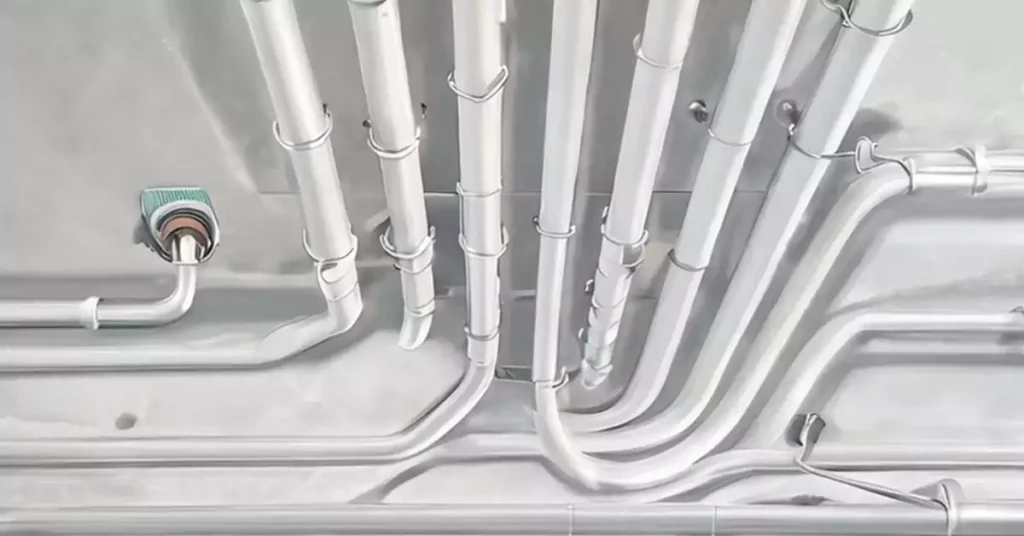
전기 레이스웨이는 전선과 케이블의 보호 경로 역할을 하여 안전하고 체계적인 설치를 보장합니다. 전선을 손상으로부터 보호하고, 안전을 강화하고, 조직을 촉진하며, 향후 수정에 대한 유연성을 제공합니다.
잘 설계된 전기 레이스웨이 시스템은 다음을 포함한 여러 가지 이점을 제공합니다.
보호: 전기 레이스웨이는 전선과 케이블을 물리적 손상, 습기, 화학 물질 및 기타 외부 요소로부터 보호합니다. 이 보호는 전선이 부식성 물질이나 기계적 스트레스에 노출될 수 있는 혹독한 환경에서 매우 중요합니다.
안전: 레이스웨이 내에 전기 도체를 포함함으로써 우발적인 접촉이나 감전의 위험이 크게 줄어듭니다. 레이스웨이는 전기적 사고를 방지하기 위해 추가적인 절연 및 보호 층을 제공합니다.
조직: 레이스웨이는 전선과 케이블을 깔끔하고 질서 있게 배열하여 어수선함을 최소화하고 유지 관리 및 문제 해결 작업을 간소화합니다. 이러한 구성은 전기 시스템의 효율성과 접근성을 향상시킵니다.
유연성: 전기 레이스웨이는 전기 회로의 수정, 추가 또는 재배선을 더 쉽게 할 수 있습니다. 광범위한 재배선 없이도 변화하는 요구 사항에 적응할 수 있는 유연성을 제공합니다.
전기 레이스웨이는 일반적으로 금속 또는 비금속 재료로 만들어지며 도관 및 케이블 트레이와 같은 다양한 형태로 제공됩니다. 레이스웨이는 기계적 보호를 제공하고 전선 손상을 방지하며 깔끔하고 체계적인 배선 시스템을 제공합니다. 이 기사에서는 주로 전기 도관 및 케이블 트레이에 대해 두 가지 다른 배선 방법을 소개합니다.
도관은 전기 도체에 보호 경로를 제공하는 전기 레이스웨이의 한 유형입니다. 주거 및 상업 환경에서 전기 와이어와 케이블을 라우팅하고 보호하는 데 일반적으로 사용됩니다. 도관은 여러 가지 용도로 사용됩니다.
보호: 도관은 전선과 케이블에 물리적 보호를 제공하여 충격, 습기 및 기타 환경적 위험으로부터 보호합니다. 우발적 손상을 방지하고 전기 시스템의 수명을 연장합니다.
라우팅: Conduit은 전기 도체에 대한 명확하게 정의된 경로를 제공하여 체계적이고 구조화된 설치를 보장합니다. 문제 해결, 유지 관리 및 향후 수정을 간소화합니다.
접지: 금속 도관은 올바르게 설치하고 접합하면 효과적인 접지 경로 역할을 하여 감전 위험을 줄이고 고장 전류 경로를 제공할 수 있습니다.
일반적인 도관 유형은 4가지입니다. 강성 금속 도관(RMC), 중간 금속 도관(IMC), 전기 금속 튜빙(EMT), PVC 도관입니다. 내구성, 유연성, 비용 효율성, 환경 요인에 대한 저항성과 같은 요인에 따라 적절한 도관 유형을 선택합니다.
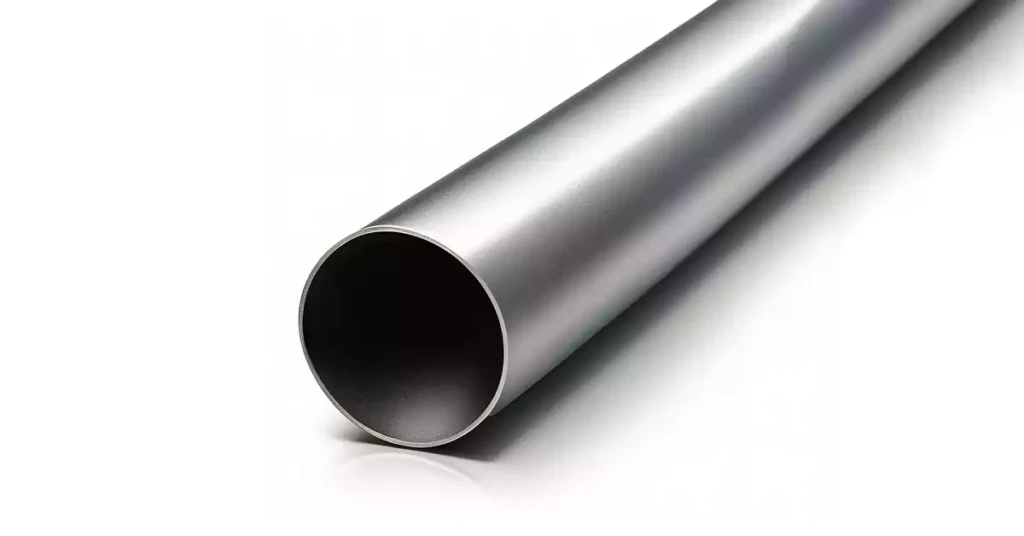
RMC는 강철로 만든 견고한 도관입니다. 우수한 기계적 보호 기능을 제공하며 충격과 압축에 매우 강합니다. RMC는 내구성과 견고성이 중요한 산업 및 상업 환경에서 일반적으로 사용됩니다.
특징: 견고한 두꺼운 벽의 도관으로 나사산이 있는 끝부분이 있어 안전한 연결을 제공합니다. 최고 수준의 기계적 보호와 뛰어난 전자기 차폐를 제공합니다.
이익: 뛰어난 내구성, 충격 저항성 및 EMI 보호. 산업 및 고위험 환경에 이상적입니다.
고려 사항: 절단 및 나사산 가공에 특수 도구가 필요합니다. 적절한 코팅이 없으면 부식되기 쉽습니다. 설치 노동력과 비용이 비교적 높습니다.
IMC는 강철로 만든 가벼운 도관입니다. RMC와 유사한 기계적 보호 기능을 제공하지만 더 큰 유연성과 설치 용이성을 제공합니다. IMC는 적당한 물리적 보호가 필요한 상업 및 산업 분야에서 자주 사용됩니다.
특징: RMC보다 가벼우며 벽이 얇습니다. 나사 연결 또는 압축 피팅을 사용하여 쉽게 설치할 수 있습니다.
이익: RMC에 비해 더 큰 유연성과 비용 효율성을 제공하면서 우수한 기계적 보호. 상업 및 산업 응용 분야에 적합합니다.
고려 사항: 효과적인 고장 전류 경로를 위해 적절한 접지가 필요합니다. 특정 환경에서는 부식에 취약합니다.
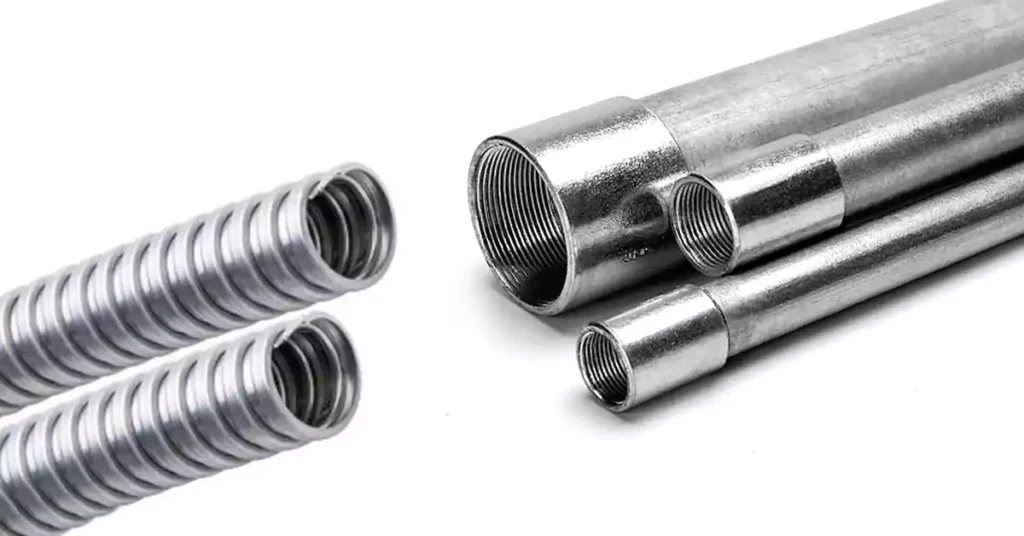
EMT는 아연 도금 강철 또는 알루미늄으로 만든 얇은 벽의 도관입니다. 가볍고 설치가 쉽고 비용 효율성이 매우 높습니다. EMT는 보통 적당한 기계적 보호가 충분한 주거 및 상업 환경에서 사용됩니다.
특징: 얇은 벽의 도관으로 내부가 매끄러워 전선을 쉽게 당길 수 있습니다. 압축 피팅이나 셋스크류 커넥터를 사용하여 빠르게 설치할 수 있습니다.
이익: 가볍고 비용 효율적이며 작업하기 쉽습니다. 적당한 기계적 보호가 충분한 주거 및 상업 분야에 이상적입니다.
고려 사항: 혹독한 환경이나 물리적 손상에 취약한 구역에서는 제한적인 보호 기능을 제공합니다.
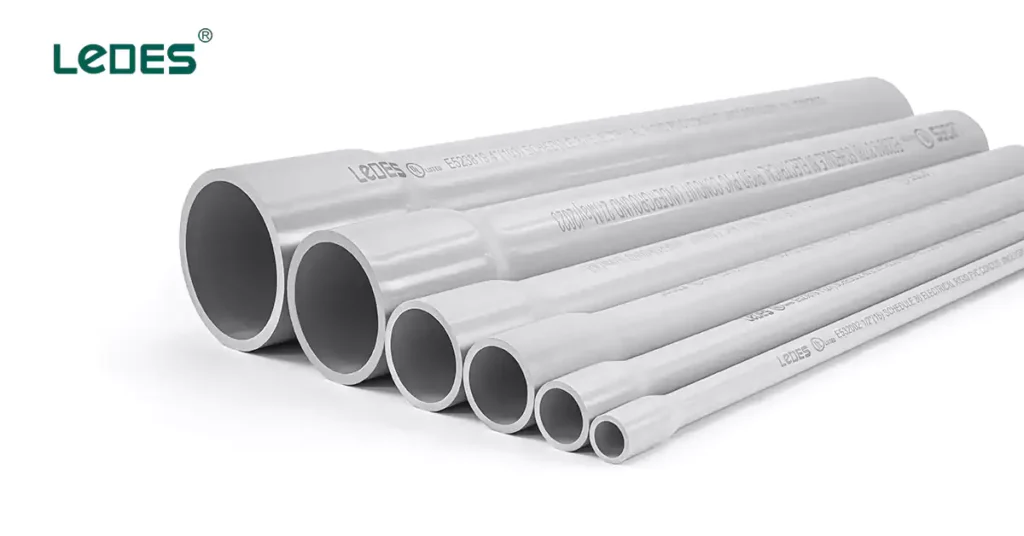
PVC 도관은 폴리염화비닐로 만든 비금속 도관입니다. 가볍고, 부식 방지이며, 뛰어난 내화학성을 제공합니다. PVC 도관은 적당한 기계적 보호가 필요한 주거 및 상업 분야에서 널리 사용됩니다.
특징: PVC로 만든 비금속 도관으로 다양한 크기와 구성으로 제공됩니다. 간단한 설치를 위해 용매 용접 또는 푸시핏 커넥터를 사용합니다.
이익: 가볍고, 부식 방지, 비용 효율적입니다. 뛰어난 내화학성을 제공하며 지상 설치에 적합합니다.
고려 사항: 금속 도관에 비해 기계적 강도가 제한적이고 극한 온도에 대한 저항성이 낮습니다.
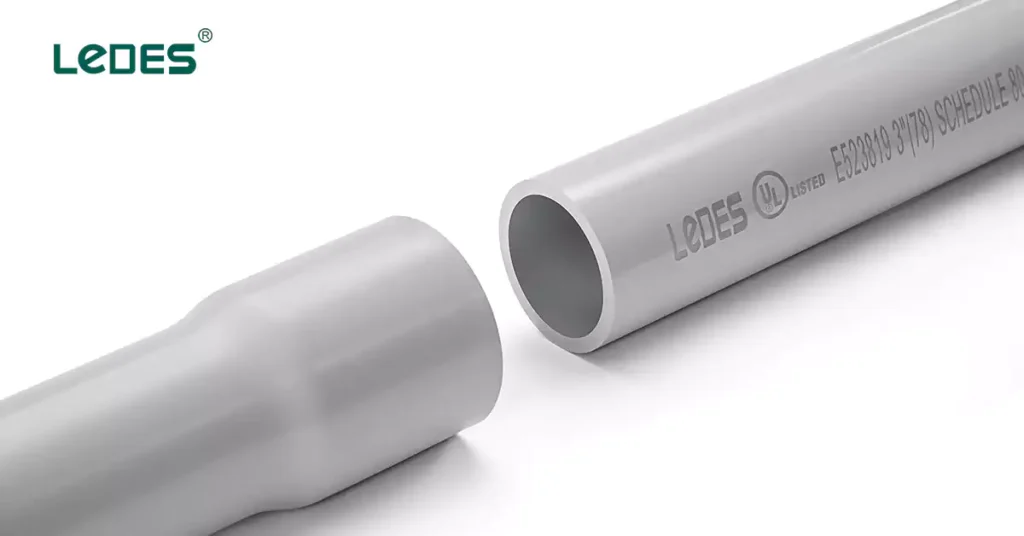
도관 설치 지침 및 모범 사례 준수: 도관을 올바르게 설치하는 것은 안전과 성능에 필수적입니다. 도관 경로를 계획하고, 크기를 고려하고, 안전한 장착 및 지지를 보장하고, 정확한 연결 및 피팅을 만들고, 전기 안전을 위해 도관을 접지하고, 전선을 당겨 고정하고, 도관을 밀봉하고, 배선에 라벨을 붙이고, 시스템에 전원을 공급하기 전에 설치를 검사하고 테스트합니다.
- 경로 계획: 접근성, 경로 제약 및 클리어런스 요구 사항을 고려하여 최적의 도관 경로를 결정합니다. 확장 및 향후 유지 관리 요구 사항을 계획합니다.
- 사이즈: 설치할 도체의 수와 크기에 따라 적절한 도관 크기를 선택합니다. 향후 확장을 위한 충분한 공간을 확보합니다. 지역 전기 코드 및 규정을 준수합니다.
- 장착 및 지원: 적절한 지지대와 패스너를 사용하여 도관을 벽, 천장 또는 기타 구조적 요소에 단단히 고정합니다. 처짐이나 과도한 응력을 피하기 위해 적절한 지지 간격을 확보합니다. 도관용으로 설계된 클램프 또는 행거를 사용합니다.
- 굽힘 및 절단: 특수 도구를 사용하여 도관을 필요한 각도로 올바르게 구부립니다. 도관 제조업체에서 제공하는 굽힘 표 또는 지침을 따릅니다. 적절한 절단 도구를 사용하여 도관을 원하는 길이로 자릅니다.
- 연결 및 피팅: 도관 유형에 적합한 승인된 커넥터, 커플링 및 피팅을 사용하십시오. 적절한 정렬과 단단한 연결을 확인하십시오. 설치에 대한 제조업체 지침을 따르십시오.
- 접지: 효과적인 고장 전류 경로를 제공하고 감전 위험을 줄이기 위해 금속 도관의 적절한 접지를 보장하세요. 승인된 방법을 사용하여 도관을 접지 도체에 접합하세요.
- 와이어 당기기 및 고정: 손상을 방지하기 위해 전선과 케이블을 도관 내부에 조심스럽게 설치하십시오. 적절한 윤활제와 당기는 도구를 사용하여 마찰을 최소화하십시오. 움직임을 방지하고 연결부의 스트레스를 최소화하기 위해 정기적으로 전선을 고정하십시오.
- 밀봉: 습기, 먼지 또는 기타 오염 물질의 유입을 방지하기 위해 도관 피팅 및 연결부를 밀봉합니다. 특정 도관 유형 및 환경 조건에 적합한 승인된 밀봉 재료 또는 방법을 사용합니다.
- 라벨링: 쉽게 식별하고 문제를 해결할 수 있도록 도관 런과 접합 상자에 적절하게 라벨을 붙입니다. 환경 조건을 견뎌낼 수 있는 영구 마커나 라벨을 사용합니다.
- 검사 및 테스트: 시스템에 전원을 공급하기 전에 도관 설치를 철저히 검사합니다. 연속성 및 절연 저항 테스트를 수행하여 적절한 전기 연결과 안전을 보장합니다.
전기 도관은 주거, 상업 및 산업 환경에서 다양한 용도로 사용됩니다. 다음은 몇 가지 일반적인 예입니다.
주거용 응용 프로그램:
– 신축 주택 건축이나 리모델링 프로젝트에서 전기 배선을 연결합니다.
– 조경 조명이나 전기 자동차 충전소와 같은 옥외 설비의 전기 도체를 보호합니다.
– 홈시어터 시스템이나 컴퓨터 네트워크의 케이블을 고정하고 정리합니다.
상업적 응용 프로그램:
– 사무실 건물, 소매점, 교육 기관에 전기 시스템 설치.
– HVAC 시스템, 조명기구, 보안 시스템을 위한 전원 및 제어 배선 라우팅.
– 데이터 센터나 서버실의 전기 장비 연결.
산업용 응용 분야:
– 제조 시설 및 산업 플랜트의 전력 분배 관리.
– 화학 공장이나 정유 공장과 같은 위험한 환경에서 전기 배선을 보호합니다.
– 산업용 기계 및 장비의 라우팅 제어 및 계측 배선.
UL, CSA, NEMA, IEC와 같은 표준화 기관은 전기 도관의 안전성, 성능 및 호환성을 보장하기 위해 테스트 및 인증 서비스를 제공합니다.
UL(Underwriters Laboratories): UL은 전선관을 포함한 다양한 전기 제품에 대한 시험과 인증을 제공하는 글로벌 안전 인증 기업입니다. UL 표준 도관이 특정한 안전 및 성능 요구사항을 충족하는지 확인하세요.
CSA(캐나다 표준 협회): CSA는 표준을 개발하고 테스트 및 인증 서비스를 제공하는 독립적인 조직입니다. 캐나다의 전기 제품CSA 표준은 도관이 캐나다의 안전 및 성능 요구 사항을 충족함을 보장합니다.
NEMA(전미 전기 제조업체 협회): NEMA는 전기 장비 및 의료 영상 제조업체의 협회입니다. NEMA는 호환성, 안전성 및 성능을 보장하기 위해 도관 및 기타 전기 제품에 대한 표준을 제공합니다.
IEC(국제 전기 기술 위원회): IEC는 다양한 전기 기술에 대한 표준을 개발하고 발표하는 국제 표준화 기구입니다. IEC 표준 전 세계적으로 인정받으며 글로벌 일관성과 상호 운용성을 보장합니다.
이러한 표준을 준수하면 도관 설치의 품질과 신뢰성을 보장하고, 안심하고 사용할 수 있으며 다양한 지역의 규제 요구 사항을 충족할 수 있습니다.
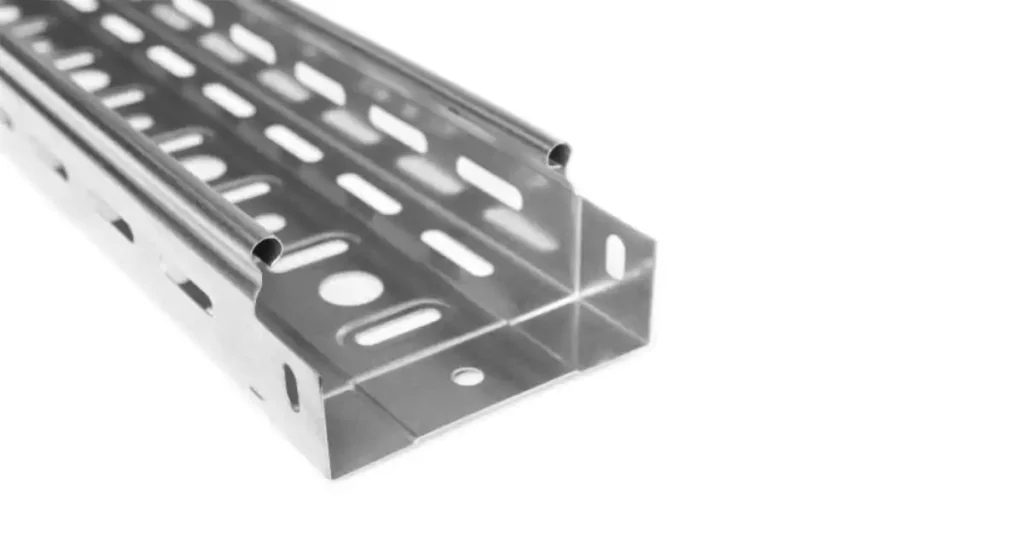
케이블 트레이는 전기 설비에서 케이블과 전선을 정리하고 보호하는 데 사용되는 지원 시스템입니다. 케이블 관리, 기계적 보호, 전자기 호환성, 유지 관리 및 문제 해결을 위한 접근성을 제공합니다.
전기 설비에서 케이블 트레이의 목적은 다음과 같습니다.
케이블 관리: 케이블 트레이는 케이블을 배선하고 지지할 수 있는 체계적인 경로를 제공하여 케이블을 체계적으로 정리하고 엉킴이나 손상을 방지합니다.
기계적 보호: 케이블 트레이는 충격, 마모, 환경 요인 등 외부 위험으로부터 케이블을 보호하여 케이블의 수명과 안정성을 보장합니다.
전자기 호환성: 케이블 트레이는 케이블을 적절히 분리하고 접지하여 전자파 간섭(EMI)을 관리하는 데 도움이 됩니다.
접근성 및 유지 관리: 케이블 트레이는 유지관리, 문제 해결, 향후 설치 또는 교체 시 케이블에 쉽게 접근할 수 있도록 해줍니다.
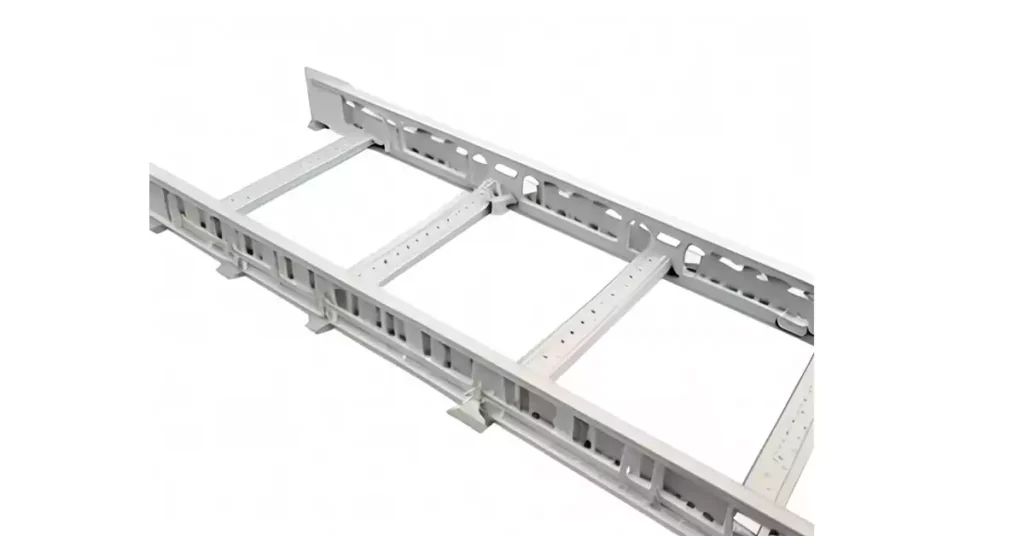
케이블 트레이에는 사다리형 케이블 트레이, 솔리드 바닥형 케이블 트레이, 통풍형 케이블 트레이, 와이어 메시 케이블 트레이, 채널형 케이블 트레이, 트로프형 케이블 트레이 등 6가지 유형이 있습니다. 각 유형은 고유한 디자인과 구조적 특징을 가지고 있어 특정 용도와 환경 조건에 적합합니다.
사다리 케이블 트레이: 사다리 케이블 트레이는 가로대에 연결된 두 개의 세로 측면 레일로 구성되어 사다리와 같은 구조를 닮았습니다. 뛰어난 통풍과 상단과 하단에서 쉽게 접근할 수 있습니다.
솔리드 바텀 케이블 트레이: 솔리드 바텀 케이블 트레이는 먼지, 흙, 습기로부터 추가 보호를 제공하는 견고한 바닥을 가지고 있습니다. 외부 요소로부터 케이블을 보호하는 것이 중요한 환경에 적합합니다.
통풍 케이블 트레이: 통풍 케이블 트레이는 길이를 따라 천공 또는 슬롯이 있어 공기 흐름과 열 발산을 증가시킵니다. 고온 환경과 같이 케이블 냉각이 필수적인 곳에서 자주 사용됩니다.
와이어 메쉬 케이블 트레이: 와이어 메시 케이블 트레이는 상호 연결된 와이어로 만들어진 격자 모양의 구조를 특징으로 합니다. 케이블 지지 및 보호를 유지하면서도 우수한 케이블 가시성, 유연성 및 공기 흐름을 제공합니다.
채널 케이블 트레이: 채널 케이블 트레이는 U자형 디자인이며 가벼운 케이블이나 도관에 적합합니다. 상단에서 쉽게 케이블을 접근할 수 있습니다.
트로프 케이블 트레이: 트로프 케이블 트레이는 깊고 직사각형 단면을 가지고 있어 많은 수의 케이블이나 부피가 큰 케이블을 관리하는 데 이상적입니다.
케이블 트레이는 도관에 비해 유연성과 확장성, 향상된 공기 흐름, 접근성 및 비용 효율성을 제공합니다. 그러나 케이블을 외부 요소에 노출시키고 물리적 보호가 제한될 수 있습니다.
유연성 및 확장성: 케이블 트레이는 재구성과 향후 케이블 추가 또는 수정을 더 쉽게 해주어 변화하는 전기적 요구에 적응할 수 있는 유연성을 제공합니다.
개선된 공기 흐름: 통풍구가 있는 케이블 트레이는 케이블 주변의 공기 흐름을 개선하여 과열 위험을 줄이고 케이블 성능을 향상시킵니다.
접근성: 케이블 트레이는 케이블에 쉽게 접근할 수 있게 하여 유지관리, 문제 해결, 업그레이드를 간소화합니다.
비용 효율성: 케이블 트레이는 도관 시스템보다 비용 효율성이 높을 수 있으며, 특히 많은 수의 케이블이 필요한 설비의 경우 더욱 그렇습니다.
외부 요소에 노출: 케이블 트레이는 케이블을 먼지, 습기 및 기타 환경 요인에 노출시킬 수 있으므로 적절한 케이블 선택 및 정기적인 검사가 필요합니다.
제한된 보호: 도관과 비교해 케이블 트레이는 충격과 외부 위험으로부터 물리적으로 보호 수준이 낮습니다.
시계: 어떤 경우에는 케이블 트레이가 도관 시스템에 비해 케이블 경로를 시각적으로 추적하기 더 어려울 수 있습니다.
케이블 트레이를 선택하고 설치할 때 다음 요소를 고려하세요.
- 하중 용량: 선택한 케이블 트레이가 케이블 무게와 추가로 적용될 수 있는 하중을 지탱할 수 있는 충분한 하중 지지 용량을 가지고 있는지 확인하세요.
- 환경 조건: 온도, 습도, 부식성 물질, 자외선 노출 등의 요소를 고려하여 특정 환경에 적합한 케이블 트레이를 선택하세요.
- 케이블 유형 및 크기: 설치되는 케이블의 종류와 크기를 수용할 수 있는 케이블 트레이를 선택하세요. 미래의 케이블 확장 요구 사항을 고려하세요.
- 설치 위치: 케이블 트레이를 실내, 실외 또는 위험한 장소에 설치할지 여부를 결정하고, 이에 따라 적절한 재료와 코팅을 선택하세요.
- 지원 및 장착: 케이블 트레이를 벽, 천장 또는 기타 구조물에 안전하게 부착하기 위해 적절한 지지 및 장착 방법을 사용해야 합니다. 온도 변화로 인한 팽창 및 수축을 고려하세요.
- 접지 및 본딩: 전기적 안전을 유지하고 전자기 간섭을 최소화하려면 접지 및 접합 요구 사항을 준수하세요.
- 규정 준수: 케이블 트레이를 선택하고 설치할 때는 해당 지역의 전기 규정, 규정 및 산업 표준을 준수하세요.
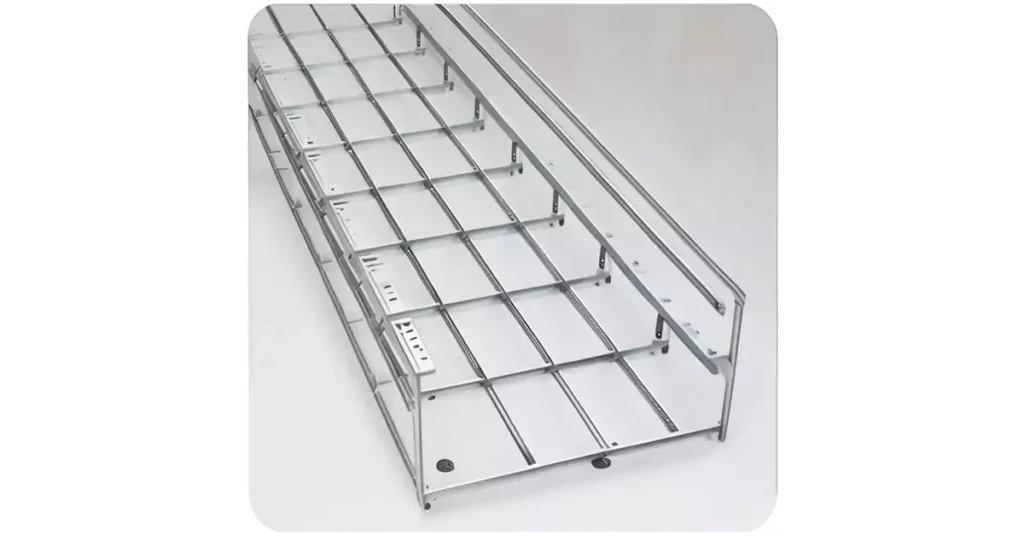
케이블 트레이는 다음을 포함한 다양한 환경에 적용됩니다.
- 상업용 건물: 케이블 트레이는 사무실 건물, 쇼핑몰, 병원, 교육 기관에서 케이블을 연결하고 관리하는 데 사용됩니다.
- 산업 시설: 케이블 트레이는 일반적으로 제조 공장, 정유 공장, 발전소, 화학 처리 시설 등에서 혹독하고 까다로운 환경에서 케이블을 정리하고 보호하는 데 사용됩니다.
- 데이터 센터: 케이블 트레이는 전력 분배, 데이터 통신, 냉각 시스템을 위한 복잡한 케이블 네트워크를 관리하기 위해 데이터 센터와 서버실에서 광범위하게 사용됩니다.
- 교통 인프라: 케이블 트레이는 공항, 지하철 시스템, 기차역과 같은 교통 인프라에서 조명, 신호, 통신 시스템을 위한 케이블을 배선하고 보호하는 데 활용됩니다.
- 야외 설비: 적절한 코팅과 방수 조치를 거친 케이블 트레이는 가로등, 교통 제어 시스템, 옥외 전력 분배 등의 옥외 설비에 사용됩니다.
케이블 트레이는 덮개가 있는 트레이와 덮개가 없는 트레이로 분류할 수 있으며, 해당 트레이의 선택은 적용 분야와 환경 조건에 따라 달라집니다.
- 덮개가 있는 트레이: 커버형 케이블 트레이는 먼지, 습기, 물리적 손상과 같은 외부 요소로부터 케이블을 보호하는 보호 커버가 있습니다. 실내 설치 또는 추가 보호가 필요한 구역에 적합합니다.
- 덮개가 없는 트레이: 덮개가 없거나 열린 케이블 트레이는 케이블에 쉽게 접근할 수 있게 해주며 케이블 관리와 접근성이 우선인 실내 환경에서 일반적으로 사용됩니다. 일반적으로 환경 요소에 노출되기 때문에 실외 애플리케이션에는 적합하지 않습니다.
- 실내 사용: 실내 애플리케이션에서 케이블 트레이는 하중 용량, 케이블 유형 및 크기 요구 사항과 미적 고려 사항에 따라 선택할 수 있습니다. 적절한 케이블 관리를 보장하는 동시에 유연성과 케이블에 대한 쉬운 접근성을 제공합니다.
- 야외 사용: 실외 설치의 경우 케이블 트레이는 기상 조건, 자외선 노출 및 부식성 요소를 견딜 수 있는 능력에 따라 선택해야 합니다. 방수 코팅, 환경 요인에 강한 재료 및 적절한 접지는 실외 케이블 트레이 설치에 필수적입니다.
실내 및 실외 사용을 위한 케이블 트레이의 적절한 선택, 설치 및 유지 관리를 위해서는 해당 지역의 전기 규정, 규정 및 제조업체 지침을 참조하는 것이 중요합니다.
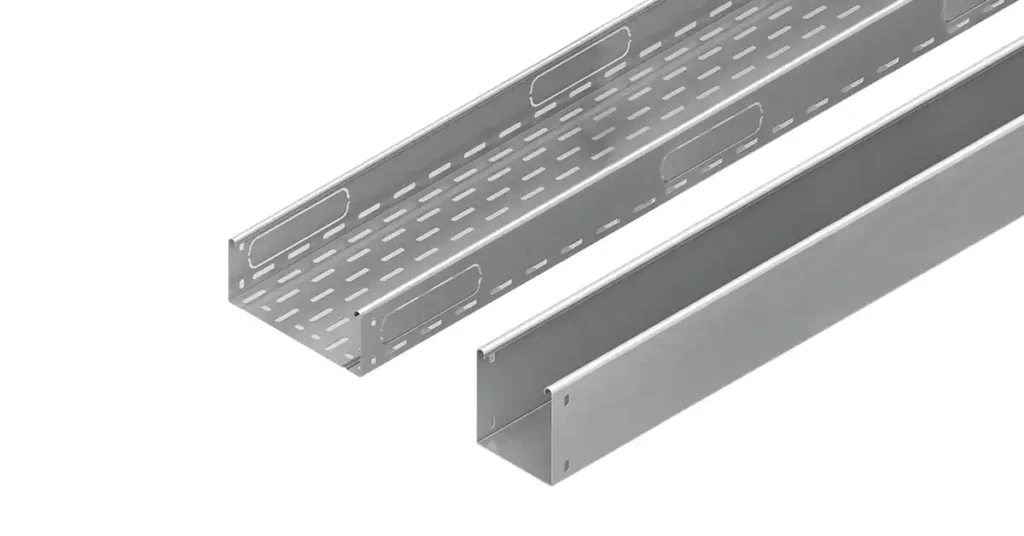
케이블 트레이에 대한 표준 및 코드는 지역 및 관할권에 따라 다를 수 있습니다. 그러나 케이블 트레이의 설계, 설치 및 사용에 대한 지침을 제공하는 널리 인정된 표준 및 코드가 몇 가지 있습니다. 일반적으로 참조되는 표준 및 코드는 다음과 같습니다.
국가 전기 규정 (NEC)
언더라이터스 연구소(UL)
캐나다 전기 규정(CEC)
국제 전기 기술 위원회(IEC)
영국 표준 (BS)
전기 피팅은 전기 설비에서 전기 장비, 장치 및 배선을 연결, 고정 및 보호하는 데 사용되는 구성 요소입니다. 전기 시스템의 안전하고 효율적인 작동을 보장하는 데 중요한 역할을 합니다. 전기 피팅은 전기 코드 및 표준을 준수하면서 전기 도체 및 장비의 적절한 설치, 라우팅 및 연결을 용이하게 합니다.
전기 설비의 중요성은 다음과 같이 요약할 수 있습니다.
안전: 전기 설비는 기계적 지지, 환경적 요인으로부터의 보호, 안전한 전기 연결을 제공하여 단락, 감전, 화재와 같은 전기적 위험의 위험을 최소화합니다.
신뢰할 수 있음: 적절하게 선택하고 설치된 전기 설비는 안정적인 전기 연결을 보장하고 장비 고장, 정전, 운영 문제의 가능성을 줄여줍니다.
편의: 전기 피팅은 깔끔하고 체계적인 배선을 가능하게 하여 전기 시스템을 관리하고 유지하기 쉽게 해줍니다. 문제 해결, 수리 및 업그레이드를 용이하게 합니다.
다음은 도관 및 케이블 트레이에 사용되는 일반적인 전기 피팅 유형과 해당 재료, 설치 방법 및 성능 특성입니다.
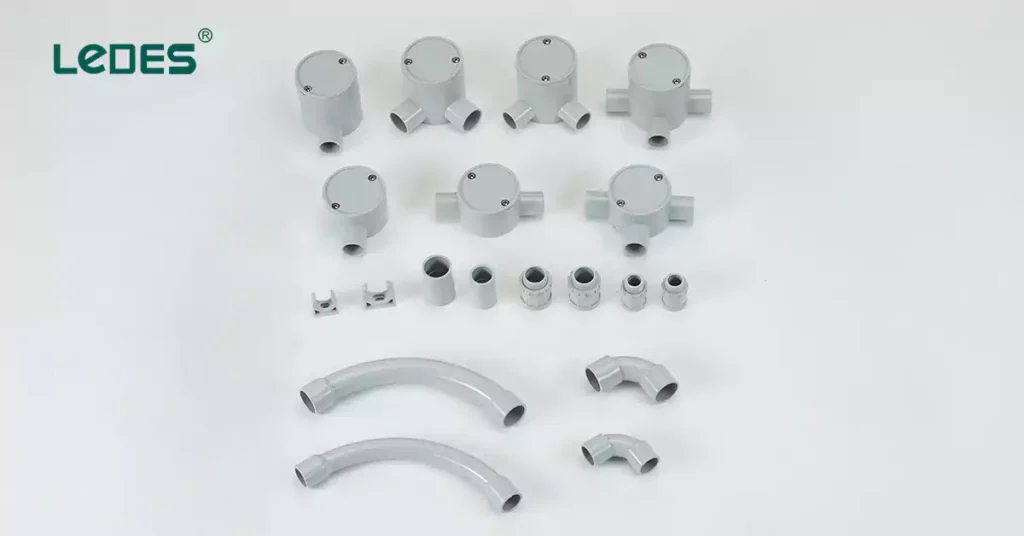
- 도관 커넥터: 도관 커넥터는 두 개의 도관 섹션을 연결하거나 도관을 전기 상자나 인클로저에 연결하는 데 사용됩니다. 압축 커넥터, 셋스크류 커넥터, 푸시인 커넥터 등 다양한 유형으로 제공됩니다. 도관 커넥터는 일반적으로 강철, 알루미늄 또는 PVC와 같은 소재로 만들어집니다. 나사나 압축 피팅을 조여 설치하여 안전하고 방수 연결이 보장됩니다.
- 콘듀트 엘보우: 콘듀이트 엘보는 콘듀이트 런의 방향을 변경하는 데 사용되어 전기 배선을 라우팅하는 데 유연성을 제공합니다. 90도 또는 45도와 같이 다양한 각도로 제공되며 강철 또는 PVC와 같은 재료로 만들 수 있습니다. 콘듀이트 엘보는 콘듀이트 끝에 부착하여 설치하여 부드러운 방향 변경이 가능합니다.
- 도관 커플링: 도관 커플링은 두 개의 도관 섹션을 직선으로 연결하는 데 사용됩니다. 강철, 알루미늄 또는 PVC를 포함하여 다양한 크기와 재질로 제공됩니다. 도관 커플링은 나사를 조이거나 압축 피팅을 사용하여 설치하여 안전하고 연속적인 도관 런을 보장합니다.
- 도관 스트랩: 도관 스트랩은 도관을 벽, 천장 또는 기타 표면에 고정하는 데 사용됩니다. 이는 지지력을 제공하고 과도한 움직임이나 진동을 방지합니다. 도관 스트랩은 강철, 알루미늄 또는 플라스틱과 같은 재료로 만들 수 있습니다. 표면에 부착하고 스트랩 내에서 도관을 고정하여 설치합니다.
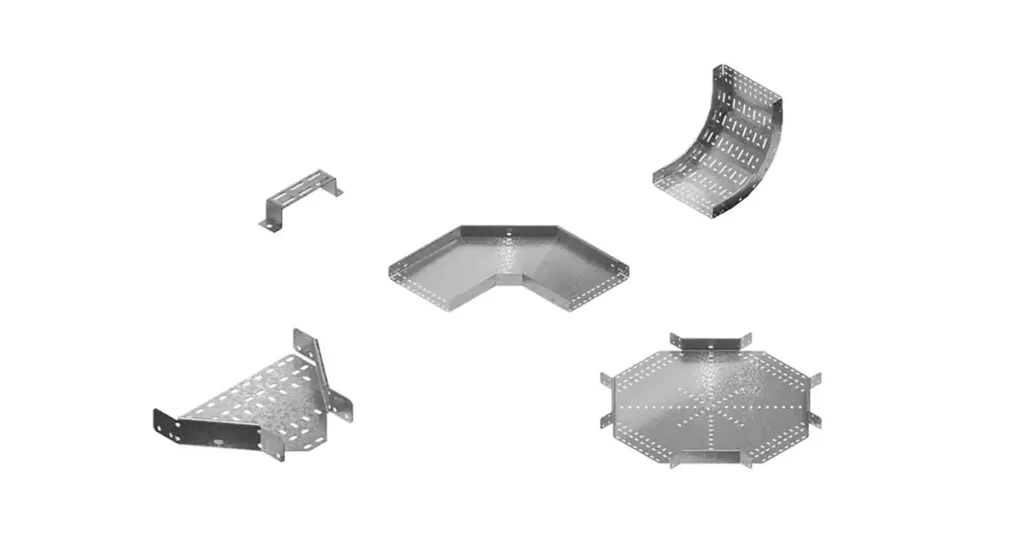
- 직선 구간: 직선 섹션은 케이블 트레이의 주요 구성 요소이며 전기 케이블의 경로를 제공합니다. 강철, 알루미늄 또는 유리 섬유와 같이 다양한 폭, 깊이 및 재료로 제공됩니다. 직선 섹션은 연속적인 케이블 트레이 런을 만들기 위해 서로 연결하여 설치됩니다.
- 굽힘과 회전: 굽힘과 회전은 케이블 트레이 런의 방향을 변경하는 데 사용됩니다. 90도 또는 45도와 같이 다양한 각도로 제공되며 강철이나 알루미늄과 같은 재료로 만들 수 있습니다. 굽힘과 회전은 케이블 트레이의 직선 섹션에 연결하여 설치하여 부드러운 방향 변경이 가능합니다.
- 티와 크로스: 티와 크로스는 케이블 트레이 시스템에서 교차점이나 분기점을 만드는 데 사용됩니다. 이를 통해 케이블을 분리하거나 여러 케이블 트레이 런을 연결할 수 있습니다. 티와 크로스는 케이블 트레이의 직선 섹션에 연결하여 설치하여 다양한 라우팅 옵션을 제공합니다.
- 지지 브라켓: 지지 브래킷은 케이블 트레이를 벽, 천장 또는 기타 구조물에 고정하고 지지하는 데 사용됩니다. 안정성을 제공하고 처짐이나 과도한 움직임을 방지합니다. 지지 브래킷은 강철이나 알루미늄과 같은 재료로 만들 수 있습니다. 표면에 부착하고 브래킷 내에서 케이블 트레이를 고정하여 설치합니다.
전기 피팅을 선택할 때는 적용 및 환경, 재료 호환성, 크기 및 용량, 코드 준수, 설치 용이성과 같은 요소를 고려하세요. 적절한 피팅 선택 및 호환성을 위해 제조업체의 권장 사항을 따르세요.
전기 안전: 전기 규정 및 표준을 충족하는 부속품을 선택하면 전기 연결의 무결성이 보장되고 단락, 아크, 과열과 같은 전기적 위험의 위험이 줄어듭니다.
신뢰할 수 있는 성능: 호환되는 피팅은 안정적인 전기 연결을 보장하여 느슨한 연결, 전압 강하 및 장비 오작동 가능성을 최소화합니다. 적절한 피팅은 또한 시간이 지남에 따라 전기 시스템의 성능을 유지하는 데 도움이 됩니다.
규정 준수: 전기 규정과 기준을 준수하는 부속품을 선택하면 설치가 안전 요구 사항을 충족하고 잠재적인 법적 문제나 처벌을 피하는 데 도움이 됩니다.
환경 보호: 설치 환경에 적합한 피팅은 습기, 먼지, 화학 물질 및 기타 환경적 요인으로부터 보호하여 전기 시스템이 손상되거나 저하되지 않도록 보호합니다.
설치 용이성: 호환 피팅은 설치가 더 쉬워 설치 시간과 노력을 줄여줍니다. 또한 전기 도체의 효율적인 라우팅과 연결을 가능하게 하여 전반적인 설치 품질을 향상시킵니다.
전기 설비를 선택할 때 고려해야 할 6가지 요소는 다음과 같습니다.
응용 프로그램 및 환경: 피팅이 사용될 특정 응용 분야와 환경 조건을 고려하십시오. 온도, 습도, 부식성 요소 및 물리적 스트레스와 같은 요소를 평가하여 피팅이 의도한 환경에 적합한지 확인해야 합니다.
재료 호환성: 피팅에 사용된 재료가 전기 시스템의 도관, 케이블 트레이 및 기타 구성 요소의 재료와 호환되는지 확인하십시오. 호환되지 않는 재료는 부식, 전기 전도도 저하 및 성능 저하로 이어질 수 있습니다.
크기 및 용량: 설치되는 전기 도체 또는 케이블에 적합한 크기와 용량의 피팅을 선택하십시오. 너무 크거나 작은 피팅은 연결 불량, 과열 또는 향후 시스템 확장에 제약을 초래할 수 있습니다.
규정 준수: 선택한 피팅이 관련 전기 코드 및 표준을 준수하는지 확인합니다. 이렇게 하면 설치가 안전 요구 사항 및 규제 지침을 충족하는지 확인할 수 있습니다.
설치 용이성: 설치 방법과 피팅의 요구 사항을 고려하세요. 설치하기 쉽고 복잡하거나 시간이 많이 걸리는 절차 없이 안전한 연결을 제공하는 피팅을 선택하세요.
제조업체 권장 사항: 피팅 선택, 설치 및 호환성에 대한 제조업체의 권장 사항 및 지침을 따르십시오. 제조업체는 종종 피팅의 적절한 사용 및 제한 사항에 대한 귀중한 정보를 제공합니다.
이러한 요소를 신중하게 고려하고 적절한 전기 설비를 선택하면 안전하고 안정적이며 규정을 준수하는 전기 설비를 보장할 수 있습니다.
전기 레이스웨이, 도관, 케이블 트레이 및 피팅은 함께 작동하여 전선이나 케이블을 보호, 경로 지정 및 지지합니다. 도관은 레이스웨이 내에서 개별 전선을 보호하는 데 사용되는 반면 케이블 트레이는 여러 케이블을 지지하고 정리하기 위한 프레임워크를 제공합니다. 피팅은 이러한 구성 요소를 연결하고 종료하는 데 중요한 역할을 합니다.
이러한 구성 요소 간의 관계는 기능적 통합에 기반합니다. 전선관은 레이스웨이 내에서 개별 전선을 보호하기 위해 사용되는 반면, 케이블 트레이는 여러 케이블을 지지하고 정리하기 위한 프레임워크를 제공합니다. 피팅은 이러한 구성 요소를 연결하고 종단하는 데 중요한 역할을 하며 안전하고 안정적인 전기 설비를 보장합니다.
이러한 요소를 결합함으로써 전기 전문가는 잘 설계되고 효율적인 전기 분배 시스템을 만들 수 있습니다. 레이스웨이, 도관, 케이블 트레이 및 피팅의 선택은 응용 프로그램, 환경, 배선 요구 사항 및 지역 전기 규정과 같은 요인에 따라 달라집니다.
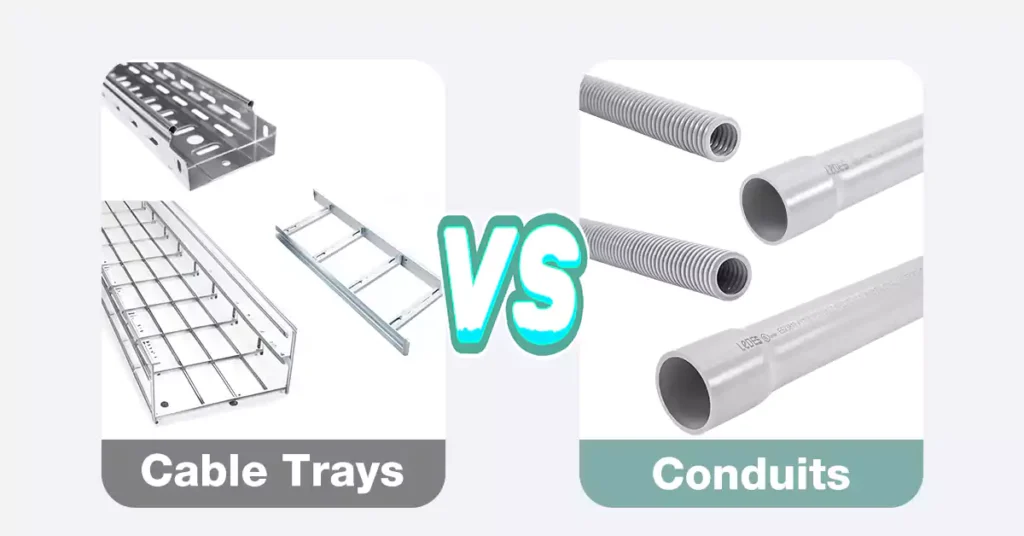
환경 조건, 케이블 용량, 설치 유연성, 코드 요구 사항과 같은 요소를 고려하여 프로젝트의 필요에 따라 도관과 케이블 트레이 중에서 선택하세요. 특정 프로젝트에 맞는 지침은 전기 전문가나 엔지니어와 상의하세요.
도관: 산업 환경, 실외 설치, 진동이 심한 지역 또는 제조 공장, 석유화학 시설, 데이터 센터 등 EMI 차폐 및 내화성이 중요한 곳에 이상적입니다.
케이블 트레이: 상업용 건물, 자주 수정되는 대규모 프로젝트, 케이블 밀도가 높은 프로젝트 또는 사무실 건물, 대학, 통신 시설 등 데이터 및 통신 케이블이 관련된 애플리케이션에 적합합니다.
프로젝트의 필요 사항을 평가하고 환경 조건, 케이블 용량, 설치 유연성, 코드 요구 사항과 같은 요소를 고려하여 도관과 케이블 트레이 중에서 정보에 입각한 결정을 내리는 것이 중요합니다. 전기 전문가 또는 엔지니어와 상담하면 특정 프로젝트에 맞는 귀중한 통찰력과 지침을 얻을 수도 있습니다.
결론적으로, 이러한 구성 요소는 케이블을 물리적 손상, 습기 및 환경 요인으로부터 보호할 뿐만 아니라 적절한 케이블 관리, 접근성 및 EMI 차폐를 보장합니다. 프로젝트 요구 사항에 따라 올바른 옵션을 선택하는 것은 효율적이고 문제 없는 전기 설비를 보장하는 데 필수적입니다.
전기 레이스웨이의 적절한 선택 및 설치는 산업 표준, 규정 및 안전 지침을 준수하는 데 필수적입니다. 이는 케이블 보호를 보장하고, 전기적 결함 및 고장 위험을 최소화하며, 유지 관리 및 문제 해결을 용이하게 합니다.
보호 요구 사항, 유연성, 용량, 환경 조건 및 EMI 차폐와 같은 요소에 대한 신중한 고려가 필요합니다. 이는 도관과 케이블 트레이 사이에서 정보에 입각한 결정을 내리는 데 도움이 됩니다. 적절한 전기 레이스웨이 시스템을 선택하고 설치함으로써 전기 시스템의 규정 준수, 보호 및 문제 없는 사용을 달성하여 전체 전기 인프라의 안정성과 수명을 보장할 수 있습니다. 전기 시스템 보호 솔루션에 대한 질문이 있으면 언제든지 저희에게 연락하십시오. 양식 제출 또는 우리에게 이메일을 보내주세요.




